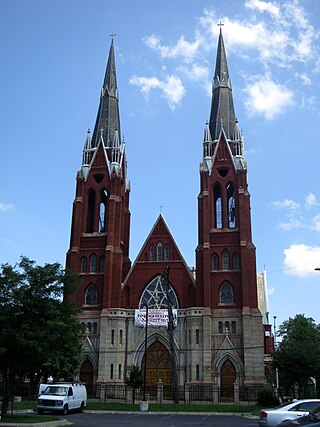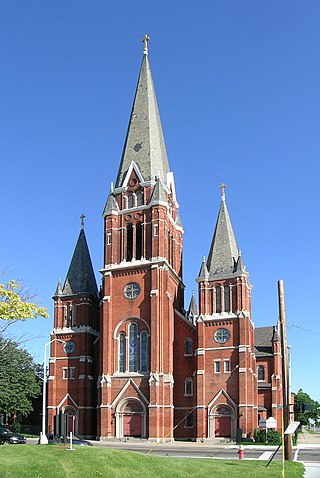
Polish Americans are Americans who either have total or partial Polish ancestry, or are citizens of the Republic of Poland. There are an estimated 8.81 million self-identified Polish Americans, representing about 2.67% of the U.S. population, according to the 2021 American Community Survey conducted by the U.S. Census Bureau.

The Polish Roman Catholic Union of America (PRCUA) is the oldest Polish American organization in the United States. Currently licensed to sell its products in 27 states, it is a fraternal benefit society providing financial security to its members through competitive life insurance and annuities, and offering opportunities for cultural, educational and spiritual growth.

Woodbridge is a historic neighborhood of primarily Victorian homes located in Detroit, Michigan. The district was listed on the National Register of Historic Places in 1980, with later boundary increases in 1997 and 2008. In addition to its historic value, Woodbridge is also notable for being an intact neighborhood of turn-of-the-century homes within walking or biking distance of Detroit's Downtown, Midtown, New Center, and Corktown neighborhoods.

St. Florian Church is a Roman Catholic Church at 2626 Poland Street in Hamtramck, Michigan. The church was designed by Ralph Adams Cram of the firm Cram and Ferguson.

The architecture of metropolitan Detroit continues to attract the attention of architects and preservationists alike. With one of the world's recognizable skylines, Detroit's waterfront panorama shows a variety of architectural styles. The post-modern neogothic spires of One Detroit Center refer to designs of the city's historic Art Deco skyscrapers. Together with the Renaissance Center, they form the city's distinctive skyline.

St. Joseph Shrine, founded in 1855, is a historic German Catholic church located at 1828 Jay Street in the Eastern Market–Lafayette Park neighborhood area just outside downtown Detroit, Michigan, on the city's central east side. The building was listed on the National Register of Historic Places in 1972, and deemed "of national importance" because of its stained glass. Three subsidiary buildings—the rectory, convent, and the Wermers House—were added to the listing in 1992. It is under the jurisdiction of the Archdiocese of Detroit, and presently a shrine dedicated to the celebration of the pre-Vatican II liturgy under the care of the canons of the Institute of Christ the King Sovereign Priest.

The Sweetest Heart of Mary Roman Catholic Church is located at 4440 Russell Street in Detroit, Michigan, in the Forest Park neighborhood on the city's central East side. The Gothic Revival cathedral styled church is the largest of the Roman Catholic churches in the City of Detroit. It was designated a Michigan State Historic Site in 1974 and listed on the National Register of Historic Places in 1978. It, along with St. Albertus Roman Catholic Church, 0.4 miles east on East Canfield Street, and St. Josaphat Roman Catholic Church, 0.3 miles west at East Canfield Street and Chrysler Drive, served the large Polish community through most of the twentieth century. In a diocesan reorganization instituted by Archbishop Allen Vigneron in 2013, Sweetest Heart of Mary joined with St. Josephat to form Mother of Divine Mercy Parish.

This is a list of the National Register of Historic Places listings in Detroit, Michigan.

St. Albertus Roman Catholic Church is in the Forest Park neighborhood of Detroit, Michigan. It was designated a Michigan State Historic Site in 1974 and listed on the National Register of Historic Places in 1978.

St. Josaphat Roman Catholic Church is a Roman Catholic church located at 715 East Canfield Street in Detroit, Michigan. It was listed on the National Register of Historic Places in 1982 and designated a Michigan State Historic Site in 1985. Since 2013, it has been one of two churches that comprise Mother of Divine Mercy Parish.

West Vernor–Junction Historic District is a commercial historic district located along West Vernor Highway between Lansing and Cavalry in Detroit, Michigan. The district includes 160 acres (0.65 km2) and 44 buildings. The district was listed on the National Register of Historic Places in 2002.

The West Vernor–Springwells Historic District is a six block long commercial historic district located along West Vernor Highway between Honorah and Norman in Detroit, Michigan. The district includes 80 acres (32 ha) and 28 buildings. It was listed on the National Register of Historic Places in 2002.

The St. Stanislaus Bishop and Martyr Roman Catholic Church is a church located at 5818 Dubois Street in Detroit, Michigan. The church was listed on the National Register of Historic Places in 1989.

St. Thomas the Apostle Catholic Church was a church located at 8363 and 8383 Townsend Avenue in Detroit, Michigan. It was listed on the National Register of Historic Places in 1989, but was subsequently demolished. and removed from the National Register of Historic Places in 2024.

St. Mary Roman Catholic Church, formally the Church of the Immaculate Conception of the Blessed Virgin Mary, is in the third oldest Roman Catholic parish in Detroit, Michigan. Designed by German-born Peter Dederichs and built for the formerly ethnic German parish of the 19th century, it is located at 646 Monroe Street in what is now considered the heart of the Greektown Historic District in downtown Detroit. It is often called "Old St. Mary's Church" to avoid confusion with other St. Mary's parishes: in the Redford neighborhood of Detroit, or in nearby Royal Oak, Monroe, or Wayne.

St. Elizabeth of Hungary Shrine is a historic Roman Catholic shrine in the Buckeye Road neighborhood on the east side of Cleveland, Ohio, United States. The earliest ethnic parish established for Hungarians in the United States, its present building was constructed in the early twentieth century, and it has been named a historic site. In 2023, it was declared a shrine church by Bishop Edward Malesic for the promotion of the Christian heritage of the Hungarian people as well divine worship according to the liturgical books in use prior to the reforms of Pope Paul VI, and is presently operated by canons of the Institute of Christ the King Sovereign Priest.

The Slovenski Dom in Rock Springs, Wyoming was built as a community hall for Slovenian fraternal organizations in 1913. The Slovenski Dom, or Slovenian National Home, was one of a number of similar halls built in places with large ethnic Slovenian populations. The organizing charter stipulated that the hall be known as the "Slovenski Dom", its name in Slovenian, rather than by its English translation. It is the only example of its kind in Wyoming and was placed on the National Register of Historic Places in 1997.

This is a list of the National Register of Historic Places listings in Downtown and Midtown Detroit, Michigan. It is intended to be a complete list of the properties and districts on the National Register of Historic Places in Downtown and Midtown neighborhoods in Detroit, Michigan, United States. Latitude and longitude coordinates are provided for many National Register properties and districts; these locations may be seen together in online maps.
In 2023, Polish Americans are most heavily concentrated in the Upper Midwest and Northeast regions of the United States. As the second most Polish populated state, Michigan follows closely behind Wisconsin with 784,200 people identifying as Polish, or 7.82% of the state's population, identifying as Polish. Many of these Polish Americans live in the Metro Detroit area of Michigan.





















